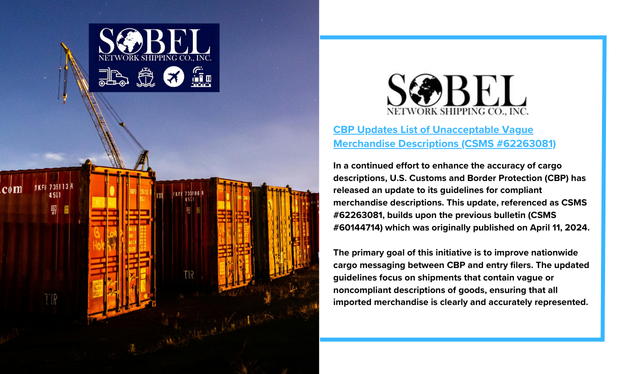In a continued effort to enhance the accuracy of cargo descriptions, U.S. Customs and Border Protection (CBP) has released an update to its guidelines for compliant merchandise descriptions. This update, referenced as CSMS #62263081, builds upon the previous bulletin (CSMS #60144714) which was originally published on April 11, 2024.
The primary goal of this initiative is to improve nationwide cargo messaging between CBP and entry filers. The updated guidelines focus on shipments that contain vague or noncompliant descriptions of goods, ensuring that all imported merchandise is clearly and accurately represented. The move to crack down on vague descriptions helps streamline the inspection process and promotes more efficient trade enforcement.
Earlier this year, CBP released an initial list of unacceptable cargo descriptions, providing a benchmark for filers to ensure compliance. The recently updated list expands on the original, incorporating additional vague terms that are no longer permissible when filing entries.
For businesses involved in international trade, it is crucial to stay informed about these updates to avoid potential delays or penalties. The full list of unacceptable vague merchandise descriptions can be accessed on the official CBP website by following this link. Staying up to date with these requirements will ensure smoother transactions and compliance with U.S. import regulations.
The updated list of unacceptable vague merchandise descriptions includes numerous additions and clarifications to help ensure better compliance with U.S. Customs and Border Protection (CBP) standards. Here’s a summary of key items:
- Brand Names: Merely stating the brand (e.g., “Bubbles Brand”) is unacceptable. Specific product descriptions like “Bubbles Brand Laundry Detergent” are required.
- Animals & Food Products: Generic terms like “animals” or “produce” are insufficient. Specific names such as “horse,” “frozen broccoli,” or “canned peaches” are required.
- Apparel & Accessories: Vague terms like “apparel” or “accessories” must be replaced with detailed descriptions, such as “women’s dresses” or “baseball caps.”
- Appliances & Electronics: Generic terms like “appliances” must be replaced with specifics like “refrigerator” or “microwave oven.” For electronics, detailed names such as “kitchen hand mixer” or “video game consoles” are necessary.
- Chemicals: Both hazardous and non-hazardous chemicals require clear identification by the actual chemical name (e.g., “Aluminum Potassium Sulfate”) or U.N. HAZMAT codes.
- Household Items & Equipment: Instead of vague descriptions such as “household goods,” specifics like “leather office chair” or “stainless steel kitchen knives” are required.
- Medical & Industrial Supplies: Detailed names like “medical gloves” and “oil well equipment” should replace generic terms like “medical supplies” or “equipment.”
- Metals & Construction Materials: General terms like “metal” or “pipes” are unacceptable. Specific descriptions like “steel beams” or “plastic pipes” are needed.
- Miscellaneous Categories: Categories like “daily necessities” or “household items” must be replaced with clear item descriptions (e.g., “plastic comb” or “shampoo”).
- Unclear Terms: Ambiguous terms like “miscellaneous” or “general cargo” should be replaced with precise descriptions for each item.
This update, effective as of August 12, 2024, emphasizes the importance of clear, specific product descriptions to avoid delays in the import process. Full details of the updated list can be found on the CBP website.


